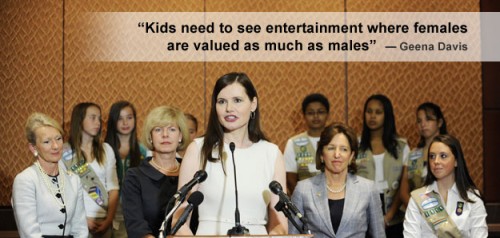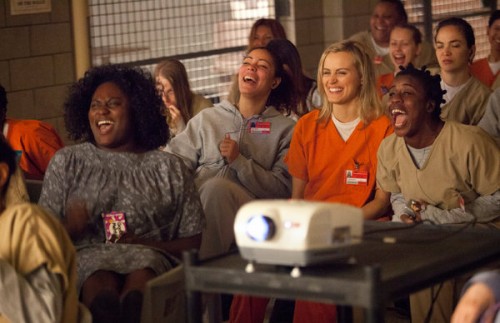This guest post by Soraya Chemaly previously appeared at The Huffington Post and is cross-posted with permission.
A new study, Gender Bias Without Borders, was released by the Geena Davis Institute on Gender in Media this recently. Conducted by Dr. Stacy Smith and a team at USC’s Annenberg School for Communications and Journalism, it looks at 120 films in the 10 most profitable film markets, globally. These films, rated G, PG, or PG-13.5 or their equivalents, were compared to similar films in the U.S. A category for U.S./UK collaboration was created since it was so common. The U.S. ranks consistently low in almost every metric.
To discuss their findings, the Institute hosted its second annual Global Symposium on Gender in Media, which I attended. The primary response I had was, how is it possible that people, especially people in this industry, remain unaware of these facts and what they mean? My second was, how do we get this information to audiences who live with the effects of this bias, but are demonstrably unaware?
Studies, other studies, show that everyday sexism is invisible to most people. One form that sexism takes, including vis-a-vis media, is that people overestimate the presence of women and their speech. It happens everywhere. It’s not that we think women are necessarily apparent or speaking as much as men, but that we expect them to be, relatively speaking, invisible and not speaking, so, by comparison, any appearance and speech is “too much.” This says a lot about status and mainstream cultural assumptions about social roles and of power.
Despite decades of research, it is apparent that we are, as a culture, so used to women being marginal that we don’t even notice. Women, as Davis points out, are only 17 percent of the people in movie crowd scenes, and yet viewers assume they are almost equally represented. That 17 percent number is super interesting, since it is also roughly the percentage of women found in leadership positions in government and business.
With very small changes, the ratio of men to women in film has remained fundamentally unchanged since 1946. As Davis put it, at this rate, “It will be 700 years before we reach parity” in U.S. media. And that parity is crucially important, not the least of which is because, as she explained, “Eighty percent of media we consume is made in the United States. We are responsible for exporting these images of girls and women to the world.” It is not a pretty picture.
20 Facts About Gender and Film in 2014
Read them and weep.
And then share widely.
- Globally, there are 2.24 male characters for every 1 female character.
- Out of a total of 5,799 speaking or named characters 30.9 percent were female, 69.1 percent male.
- Films for children had similar ratios, with only 29.2 percent having female protagonists.
- Less than a quarter of films surveyed (23.3 percent) had a female lead or co-lead.
- The U.S./UK hybrids and Indian films were in the bottom third for gender-balance, with less than a quarter of speaking roles going to female characters. In the U.S./U.K. hybrids, 23.6 percent and in Indian films, 24.9 percent.
- These on-screen ratios mirror behind the camera realities. Out of 1,452 filmmakers whose gender was identifiable, 20.5 percent were female compared to 79.5 percent who are male.
- Females are 7 percent of directors, 19.7 percent of writers, and 22.7 percent of producers.
- France has the worse gender ratio, 9.1 men to 1 woman.
- Brazil has the best, 1.7 men to 1 woman. The U.S.? 3.4 men to 1 woman.
- When women direct films there are 6.8 percent more women in them. When women are screen writers, there are 7.5 percent more women. As the report points out, however, this may not be a good thing. “This explanation reflects the old age, “write what you know.” On the other hand, women maybe given these projects to write and direct that include more female characters. This second and latter explanation is more problematic, as it restricts the range of open directing and writing opportunities given to women.”
- How gender is represented is also consistently problematic, particularly when you consider the influence media has on children’s imagination and self-conception. Female characters are more than twice as likely to be wearing sexy and sexualizing clothes (24.8 percent vs. 9.4 percent).
- Female characters are more than twice as likely to be skinny (38.5 percent vs. 15.7 percent).
- Female characters are more than twice as likely to be either partially or fully naked (24.2 percent vs. 11.5 percent).
- In films, comments made by characters that refer to appearance are directed at women at a rate of FIVE times that of comments directed at men.
- For films with fictional characters for younger children, in which the characters were aged 13-39, females are equally disproportionately sexualized. Even worse, however, is that in kids films, female characters are even more likely than in adult films to be thin.
- In the U.S., for example, although women make up 46.3 percent of the workforce, they are only 23.2 percent of characters who work on film. This is one of the largest representational differences among all the countries measured. Needless to say, nowhere were women overrepresented as working for pay.
- India had the smallest discrepancy in depictions of work: women make up 25.3 percent of the off screen workforce and 15.6 percent on the onscreen one.
- When researchers looked at characters who were executives, as a marker of leadership representation, women made up 13.9 percent. There were not enough of them to have country breakdowns. While the study notes that “Across the global sample, occupational power is at odds with female participation,” that number, 13.9 percent is actually not too far off the mark. In the U.S. 17 percent of executives in the Top 100 companies are women, internationally that number is 24 percent. Women make up only 3 percent of CEOs globally.
- Men are much more likely to be seen as attorneys and judges (13 to 1), academics (16 to 1), doctors and medical practitioners (5 to 1). Just three female characters were represented as political leaders with power. One didn’t speak. One was an elephant. The last was Margaret Thatcher.
- Men were represented in STEM jobs area at a ratio of 7 to one. In the U.S., where women make up 24 percent of the STEM workforce, men made up 87.5 percent of STEM job workers.
I am grateful for organizations like the ones that came together (the UNWomen and the Rockefeller Foundation sponsored this work) to do this study, but I am tired of reading statistics like this.
Executives at the meeting I attended, women, expressed being “startled” by the data and I had to ask, “How is that possible in 2014?” Men have disproportionate industry potential to be change agents. Where are they? The room I sat in was 90 percent women. Media and entertainment management, like most other industries’, is lacking in diversity. Men with influence and the ability to raise these questions and do something about them probably strive, as individuals, to be good parents to their kids and make sure their daughters are healthy, happy, educated and ambitious. Not doing anything about this problem, from an institutional perspective, undoes all of that effort. The argument that there is some kind of benign “neutral” position is misguided. Same goes for parents.
Boys and men are done a massive disservice from these media portrayals as well. The flip side of these biased portrays contribute to inhumane, unrealistic stereotypes about masculinity based on control, violence, dominance and the active erasure of empathy as an acceptable emotion. A narrow, frequently violent, power-over-others male heroism comes at a very high price for everyone. As filmmaker Abigail Disney, a panelist, asked, along with women, there is another notable absence, “Where are the men who solve problems by thinking?”

Doing nothing perpetuates a discriminatory and harmful status quo. When progressive movie stars, the most prominent and well-paid being men, sit at a table, when liberal-minded executives review scripts, when open-minded producers are hiring — why is this not front and center? Davis recommends two very simple steps when scripts are being reviewed: change “he” to “she” for characters and make sure crowd scenes are gender balanced.
“Film executives were raised on this media, too. Just as women are underrepresented on screen they are missing in the real world,” explains Davis. These are not unrelated realities.
You may at this point be saying, “It’s all about the money.” Except, it’s not. Films featuring women in meaningful roles make more money. What does that leave us with? Consumer education. When will we draw a line? It’s not just about withholding money, but actively supporting women filmmakers and movies that feature diversity, fully dimensional female characters such as those featured in the annual Athena Film Festival.
Many made the point that, for the most part, moviegoers are unaware of the biases. Consumers are not going to theaters thinking about gender or how its representation impacts their and their children’s lives, boys and girls both. Media is how we train girls and women to have low expectations and train boys to have high ones. Girls to exhibit submissiveness and self-objectification, boys to express dominance and control. This isn’t a passive process.
“Filmmakers make more than just movies,” explains Smith. “They make choices. The choice could be for gender equality.” There is no excuse for not having this information and using it.
Researchers took pains to explain the limitations of their study and make good recommendations for improvement, further courses of inquiry and necessary steps that can be taken to address what is clearly a significant problem in our story-telling, especially for children.
What can you do? Share these facts, talk about them with educators, coaches, family, friends. Family friendly films are among the biggest problems. Talk to your kids. Don’t let this everyday sexism go unremarked upon. Vote with your wallet. Tell your local theatre to improve their programming.
The representation of gender in these films shapes imaginations and identity, aspirations and ambition. These depictions teach girls and boys about how culture sees them: their worth, their relative value, the roles they “should” play. Girls and women, infinitely diverse in their interests, appearance, ambition, ability, aspirations, make up more than 50 percent of the human population, but you would never know any of this watching our top grossing films. Really, how can we continue telling these fundamentally destructive stories to children?
Soraya L. Chemaly writes about feminism, gender and culture. Her work appears in The Huffington Post, The Feminist Wire, BitchFlicks, Fem2.0, Alternet and Feministe among other media. She considers it a major accomplishment that the people in her house dance with abandon. Follow on Tumblr, Facebook, Feminism’s Fantastic, Twitter @schemaly












